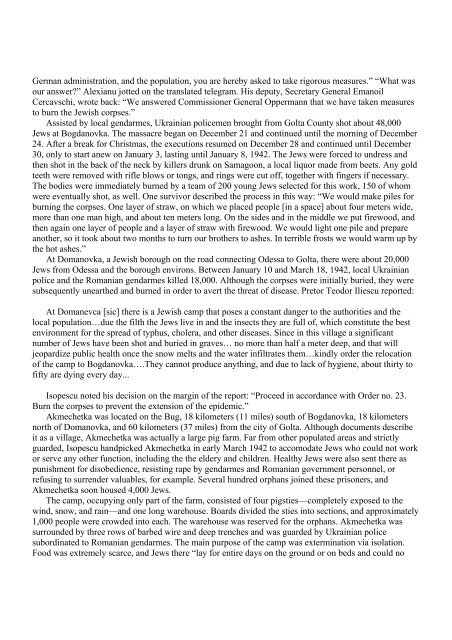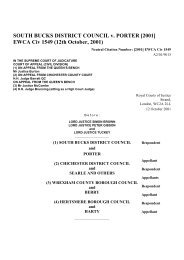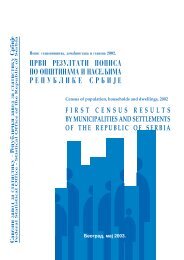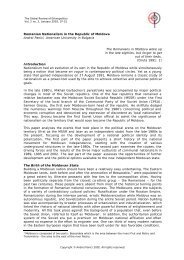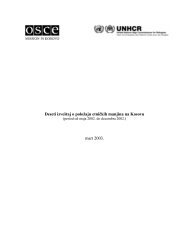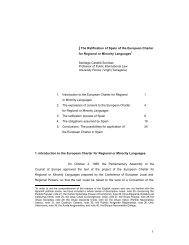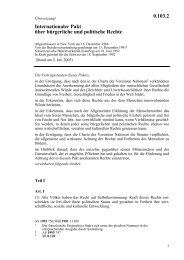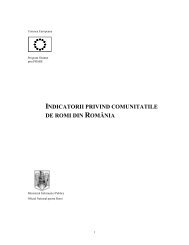Final Report of the International Commission on the - Minority Rights ...
Final Report of the International Commission on the - Minority Rights ...
Final Report of the International Commission on the - Minority Rights ...
You also want an ePaper? Increase the reach of your titles
YUMPU automatically turns print PDFs into web optimized ePapers that Google loves.
German administrati<strong>on</strong>, and <str<strong>on</strong>g>the</str<strong>on</strong>g> populati<strong>on</strong>, you are hereby asked to take rigorous measures.” “What was<br />
our answer?” Alexianu jotted <strong>on</strong> <str<strong>on</strong>g>the</str<strong>on</strong>g> translated telegram. His deputy, Secretary General Emanoil<br />
Cercavschi, wrote back: “We answered <str<strong>on</strong>g>Commissi<strong>on</strong></str<strong>on</strong>g>er General Oppermann that we have taken measures<br />
to burn <str<strong>on</strong>g>the</str<strong>on</strong>g> Jewish corpses.”<br />
Assisted by local gendarmes, Ukrainian policemen brought from Golta County shot about 48,000<br />
Jews at Bogdanovka. The massacre began <strong>on</strong> December 21 and c<strong>on</strong>tinued until <str<strong>on</strong>g>the</str<strong>on</strong>g> morning <str<strong>on</strong>g>of</str<strong>on</strong>g> December<br />
24. After a break for Christmas, <str<strong>on</strong>g>the</str<strong>on</strong>g> executi<strong>on</strong>s resumed <strong>on</strong> December 28 and c<strong>on</strong>tinued until December<br />
30, <strong>on</strong>ly to start anew <strong>on</strong> January 3, lasting until January 8, 1942. The Jews were forced to undress and<br />
<str<strong>on</strong>g>the</str<strong>on</strong>g>n shot in <str<strong>on</strong>g>the</str<strong>on</strong>g> back <str<strong>on</strong>g>of</str<strong>on</strong>g> <str<strong>on</strong>g>the</str<strong>on</strong>g> neck by killers drunk <strong>on</strong> Samago<strong>on</strong>, a local liquor made from beets. Any gold<br />
teeth were removed with rifle blows or t<strong>on</strong>gs, and rings were cut <str<strong>on</strong>g>of</str<strong>on</strong>g>f, toge<str<strong>on</strong>g>the</str<strong>on</strong>g>r with fingers if necessary.<br />
The bodies were immediately burned by a team <str<strong>on</strong>g>of</str<strong>on</strong>g> 200 young Jews selected for this work, 150 <str<strong>on</strong>g>of</str<strong>on</strong>g> whom<br />
were eventually shot, as well. One survivor described <str<strong>on</strong>g>the</str<strong>on</strong>g> process in this way: “We would make piles for<br />
burning <str<strong>on</strong>g>the</str<strong>on</strong>g> corpses. One layer <str<strong>on</strong>g>of</str<strong>on</strong>g> straw, <strong>on</strong> which we placed people [in a space] about four meters wide,<br />
more than <strong>on</strong>e man high, and about ten meters l<strong>on</strong>g. On <str<strong>on</strong>g>the</str<strong>on</strong>g> sides and in <str<strong>on</strong>g>the</str<strong>on</strong>g> middle we put firewood, and<br />
<str<strong>on</strong>g>the</str<strong>on</strong>g>n again <strong>on</strong>e layer <str<strong>on</strong>g>of</str<strong>on</strong>g> people and a layer <str<strong>on</strong>g>of</str<strong>on</strong>g> straw with firewood. We would light <strong>on</strong>e pile and prepare<br />
ano<str<strong>on</strong>g>the</str<strong>on</strong>g>r, so it took about two m<strong>on</strong>ths to turn our bro<str<strong>on</strong>g>the</str<strong>on</strong>g>rs to ashes. In terrible frosts we would warm up by<br />
<str<strong>on</strong>g>the</str<strong>on</strong>g> hot ashes.”<br />
At Domanovka, a Jewish borough <strong>on</strong> <str<strong>on</strong>g>the</str<strong>on</strong>g> road c<strong>on</strong>necting Odessa to Golta, <str<strong>on</strong>g>the</str<strong>on</strong>g>re were about 20,000<br />
Jews from Odessa and <str<strong>on</strong>g>the</str<strong>on</strong>g> borough envir<strong>on</strong>s. Between January 10 and March 18, 1942, local Ukrainian<br />
police and <str<strong>on</strong>g>the</str<strong>on</strong>g> Romanian gendarmes killed 18,000. Although <str<strong>on</strong>g>the</str<strong>on</strong>g> corpses were initially buried, <str<strong>on</strong>g>the</str<strong>on</strong>g>y were<br />
subsequently unear<str<strong>on</strong>g>the</str<strong>on</strong>g>d and burned in order to avert <str<strong>on</strong>g>the</str<strong>on</strong>g> threat <str<strong>on</strong>g>of</str<strong>on</strong>g> disease. Pretor Teodor Iliescu reported:<br />
At Domanevca [sic] <str<strong>on</strong>g>the</str<strong>on</strong>g>re is a Jewish camp that poses a c<strong>on</strong>stant danger to <str<strong>on</strong>g>the</str<strong>on</strong>g> authorities and <str<strong>on</strong>g>the</str<strong>on</strong>g><br />
local populati<strong>on</strong>…due <str<strong>on</strong>g>the</str<strong>on</strong>g> filth <str<strong>on</strong>g>the</str<strong>on</strong>g> Jews live in and <str<strong>on</strong>g>the</str<strong>on</strong>g> insects <str<strong>on</strong>g>the</str<strong>on</strong>g>y are full <str<strong>on</strong>g>of</str<strong>on</strong>g>, which c<strong>on</strong>stitute <str<strong>on</strong>g>the</str<strong>on</strong>g> best<br />
envir<strong>on</strong>ment for <str<strong>on</strong>g>the</str<strong>on</strong>g> spread <str<strong>on</strong>g>of</str<strong>on</strong>g> typhus, cholera, and o<str<strong>on</strong>g>the</str<strong>on</strong>g>r diseases. Since in this village a significant<br />
number <str<strong>on</strong>g>of</str<strong>on</strong>g> Jews have been shot and buried in graves… no more than half a meter deep, and that will<br />
jeopardize public health <strong>on</strong>ce <str<strong>on</strong>g>the</str<strong>on</strong>g> snow melts and <str<strong>on</strong>g>the</str<strong>on</strong>g> water infiltrates <str<strong>on</strong>g>the</str<strong>on</strong>g>m…kindly order <str<strong>on</strong>g>the</str<strong>on</strong>g> relocati<strong>on</strong><br />
<str<strong>on</strong>g>of</str<strong>on</strong>g> <str<strong>on</strong>g>the</str<strong>on</strong>g> camp to Bogdanovka….They cannot produce anything, and due to lack <str<strong>on</strong>g>of</str<strong>on</strong>g> hygiene, about thirty to<br />
fifty are dying every day...<br />
Isopescu noted his decisi<strong>on</strong> <strong>on</strong> <str<strong>on</strong>g>the</str<strong>on</strong>g> margin <str<strong>on</strong>g>of</str<strong>on</strong>g> <str<strong>on</strong>g>the</str<strong>on</strong>g> report: “Proceed in accordance with Order no. 23.<br />
Burn <str<strong>on</strong>g>the</str<strong>on</strong>g> corpses to prevent <str<strong>on</strong>g>the</str<strong>on</strong>g> extensi<strong>on</strong> <str<strong>on</strong>g>of</str<strong>on</strong>g> <str<strong>on</strong>g>the</str<strong>on</strong>g> epidemic.”<br />
Akmechetka was located <strong>on</strong> <str<strong>on</strong>g>the</str<strong>on</strong>g> Bug, 18 kilometers (11 miles) south <str<strong>on</strong>g>of</str<strong>on</strong>g> Bogdanovka, 18 kilometers<br />
north <str<strong>on</strong>g>of</str<strong>on</strong>g> Domanovka, and 60 kilometers (37 miles) from <str<strong>on</strong>g>the</str<strong>on</strong>g> city <str<strong>on</strong>g>of</str<strong>on</strong>g> Golta. Although documents describe<br />
it as a village, Akmechetka was actually a large pig farm. Far from o<str<strong>on</strong>g>the</str<strong>on</strong>g>r populated areas and strictly<br />
guarded, Isopescu handpicked Akmechetka in early March 1942 to accomodate Jews who could not work<br />
or serve any o<str<strong>on</strong>g>the</str<strong>on</strong>g>r functi<strong>on</strong>, including <str<strong>on</strong>g>the</str<strong>on</strong>g> <str<strong>on</strong>g>the</str<strong>on</strong>g> eldery and children. Healthy Jews were also sent <str<strong>on</strong>g>the</str<strong>on</strong>g>re as<br />
punishment for disobedience, resisting rape by gendarmes and Romanian government pers<strong>on</strong>nel, or<br />
refusing to surrender valuables, for example. Several hundred orphans joined <str<strong>on</strong>g>the</str<strong>on</strong>g>se pris<strong>on</strong>ers, and<br />
Akmechetka so<strong>on</strong> housed 4,000 Jews.<br />
The camp, occupying <strong>on</strong>ly part <str<strong>on</strong>g>of</str<strong>on</strong>g> <str<strong>on</strong>g>the</str<strong>on</strong>g> farm, c<strong>on</strong>sisted <str<strong>on</strong>g>of</str<strong>on</strong>g> four pigsties—completely exposed to <str<strong>on</strong>g>the</str<strong>on</strong>g><br />
wind, snow, and rain—and <strong>on</strong>e l<strong>on</strong>g warehouse. Boards divided <str<strong>on</strong>g>the</str<strong>on</strong>g> sties into secti<strong>on</strong>s, and approximately<br />
1,000 people were crowded into each. The warehouse was reserved for <str<strong>on</strong>g>the</str<strong>on</strong>g> orphans. Akmechetka was<br />
surrounded by three rows <str<strong>on</strong>g>of</str<strong>on</strong>g> barbed wire and deep trenches and was guarded by Ukrainian police<br />
subordinated to Romanian gendarmes. The main purpose <str<strong>on</strong>g>of</str<strong>on</strong>g> <str<strong>on</strong>g>the</str<strong>on</strong>g> camp was exterminati<strong>on</strong> via isolati<strong>on</strong>.<br />
Food was extremely scarce, and Jews <str<strong>on</strong>g>the</str<strong>on</strong>g>re “lay for entire days <strong>on</strong> <str<strong>on</strong>g>the</str<strong>on</strong>g> ground or <strong>on</strong> beds and could no


